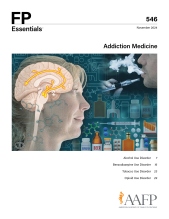
This edition of FP Essentials addresses substance use disorders, a group of conditions that many physicians are increasingly familiar with. In this edition, use disorders involving tobacco, alcohol, opioids, and benzodiazepines are covered. As the authors of this edition detail, these conditions are common, but the way they present has changed with time.
The use of tobacco products is a clear example of these changes. Data from 2023 show that roughly 10% of adults older than 18 years smoke cigarettes, compared with more than 20% in 2005 and more than 33% in 1979.1,2 This is good news, but it is offset by increased use of electronic nicotine delivery systems (eg, e-cigarettes), particularly among young people. In 1990, nearly 30% of 12th graders reported smoking cigarettes. In 2020, that percentage had decreased to 7.5%, but 24.7% reported vaping. In the same period, more than 10% of 8th graders reported vaping tobacco within the previous 30 days.3 Section 3 covers tobacco use disorder and how to help patients reduce or quit tobacco use.
Alcohol use has also changed. The overall rate of use has decreased substantially. In 2000, 50% of 12th graders reported using alcohol and 30% reported binge drinking, compared with 33% reporting recent use and approximately 17% reporting binge drinking in 2023. Even so, approximately 50% of US adults older than 18 years drink alcohol regularly, and 25% report binge drinking within the previous year.4 Section 1 details the harms of alcohol use and explains what is known about the risks.
Opioid use disorder and nonmedical use of prescription drugs (specifically benzodiazepines) are also covered in this edition. Both conditions are commonly seen in primary care, although they are less common than tobacco or alcohol use disorder.5 The mortality rate from opioid overdose has increased steadily for at least the past 20 years and surged during the COVID-19 pandemic.6 The Centers for Disease Control and Prevention has noted an increase in overdose deaths from legal and illegal use of benzodiazepines and opioids.7 Sections 2 (benzodiazepines) and 4 (opioids) review how to diagnose and manage these use disorders.
Substance use disorders are common and impactful to our patients and their families. They are lifelong, chronic conditions, and family physicians are truly best positioned to care for patients with these conditions. I hope you find this edition useful in your practice.
Kate Rowland, MD, FAAFP, Associate Medical Editor
Vice Chair of Education and Associate Professor
Department of Family and Preventive Medicine
Rush University, Chicago, Illinois
